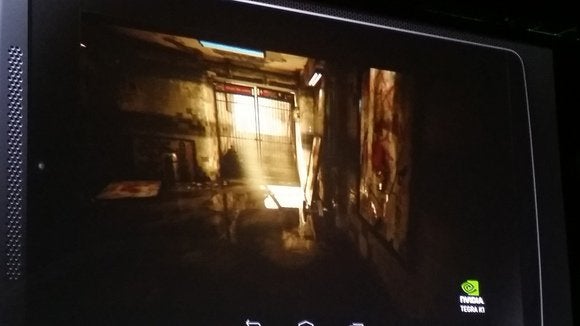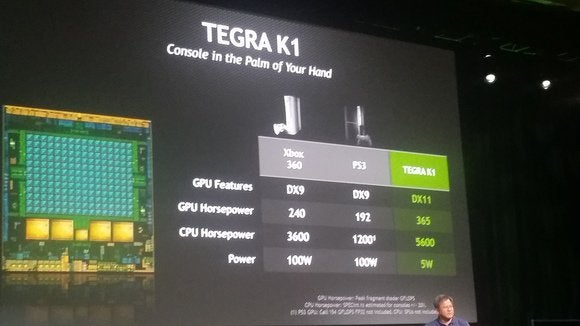Many expected Nvidia to launch a next-generation Tegra 5 platform at the Consumer Electronics Show. Instead, Nvidia arguably went quite a bit farther.
Nvidia announced the Nvidia K1, a mobile processor with 192 graphics cores, which chief executive Jen Hsun Huang positioned as a mobile game console. There will be a version of the chip with traditional 32-bit "4+1" ARM cores like Tegra 4, and even a version with a dual-core 64-bit "Denver" CPU, the ARM chip that Nvidia announced in 2011. There will even be a third option for cars.
A year ago, Nvidia launched "Project Shield," a handheld gaming device based on the Nvidia Tegra 4 mobile chip. Project Shield served both as a mobile game console that would compete with the PlayStation Vita, Android gaming tablets, and other portable gaming solutions, as well as a device to stream games from PCs powered by Nvidia GeForce hardware. Nvidia also launched GeForce Experience, a software application that automatically optimizes the settings of PC games to maximize their performance when running on Nvidia hardware, and Grid, a rack server that could process graphics-intensive applications and deliver them to clients.

The next-gen Unreal Engine 4, running on the Nvidia K1 hardware.
Nvidia is working to build an ecosystem similar to those of Intel and AMD, with offerings that stretch from the embedded space on up to the server. According to Kevin Krewell, an analyst at Tirias Research, an important announcement was the "Denver"-based version of the K1, signaling that Nvidia has entered the ARM generation, following Apple.
The new Tegra chip is less about the number of cores than the total amount of graphics horsepower, Krewell said. "It's about the gigaflops," he said. "It's a lot of [graphics] power for an [embedded device]. It's also the first time they've brought their CUDA language to a mobile chip -- they've come out with guns blazing."
The legacy PC
Huang said that the GeForce chip and its new GameStream service now allows you to record and stream games and stream to services like Twitch, which allows 15 million spectators and more each month to watch others play. Huang demoed "Batman: Arkahm Origins" streaming on a Project Shield machine, using a GeForce-based Grid as the original rendering engine. From there, the game was streaming to the Internet. The kicker? It was streaming from France, Huang said.
"For it to be completely interactive, and because we can notice anything higher than 200 ms of latency, consider how little time that takes on the back end to go through all of the graphics processing."
Frame rates in games tend to stutter and lag, with GPU-intensive explosions and actions from multiple players making it difficult to maintain the 60-hertz frame rate that's a legacy of traditional monitors. The challenge for Nvidia was to make the game smooth in a way that was governed by the GPU, not the monitor. Traditional monitor V-sync (vertical synchronization) results in judders as the screen as sampled again. Solutions include double and triple buffering, which adds latency to the system, or disabling v-sync, which can lead to visual artifacts like "tearing."
Nvidia developed G-Sync, a technology that updates monitor's display when the GPU is ready, without lag or tearing. It will require special G-Sync equipped monitors and Nvidia graphics cards, and will be available in the second quarter from "just about every monitor maker that targets gamers," Huang sad.
"The Android operating system is undoubtedly the single most disruptive force in computing in the last hundred years," Huang said. "When we think about building Tegra, our mobile processor, we think about what we can do to take Tegra into markets we can serve."
"There are some new industries that Tegra will advance to, including 4K televisions, a market that Huang said that was a question of "if, not when." It's only a question of time before Android disrupts the game console industry, Huang added—although he had to do so, with all three consoles dominated by AMD hardware.
Meet the Tegra K1
Most were expecting Nvidia to announce the Tesla 5, a next-generation core to the Nvidia Tegra 4 mobile chip. Instead, Huang announced the Tegra K1, the world's first 192-core processor, with 192 Kepler cores inside it.

Nvidia will manufacture two main versions of the Nvidia K1.
"It's also most inappropriate to call it the Tegra K5, because it's simply not linear," Huang said, referring to the rate of improvement within the chip.
"We've brought Tesla to the same levels as supercomputing," Huang said. "We've brought the heart of GeForce and the soul of Tesla to mobile computing."
The K1 so impressed one developer, Epic Games, that it said it would bring its next-generation Unreal engine to the K1 platform. "The Unreal Engine is essentially the OS of gaming," Huang said.
Huang positioned the Tegra K1 as significantly more powerful than either than Xbox 360 or the PlayStation 3. Though at seven years old, with their successors already on the market, that is not a terribly meaningful comparison.

A game console in a chip? Nvidia would have you think so.
Huang promised that next-generation engines like the Unreal engine would feature photorealism—a promise that game developers and GPU vendors have repeated for years now. But every chip takes a step further toward that goal, and Nvidia showed off a demo from the USC Institute for Creative Technologies running on the Nvidia K1 that showed off an amazingly lifelike animated human head. Other demos showed off high-dynamic range lighting and features like volumetric fog.
Huang also showed off Uneal Engine 4 running on the K1 archiecture, which looked, naturally, like the most realistic to date. One of the presenters demonstrating the technology noted that Epic has a technology that automatically adjusts for what it called adaptive pupil technology, which attempts to paint the scene in the way which a human eye would see them. Even tiny paticles have their own physics effects, Huang said.
To take a scene from a "cartoon" to "reality" takes subtle effects that fool the eye. Those include physically based rendering and global, nondirectional lighting. Of one example, Huang said, "that couch doesn't look soft, it looks like I could sit on it! I bet I could find quarters underneath it."
Nvidia also showed off Frozenbyte's Trine 2, a last-generation PC game now running on the mobile Tegra K1.
Finally, Huang showed off the power of GeForce Grid to provide a real-time ray-tracing engine. Ray tracing, which models the flight light rays as they move through the air, creates very realistic lighting and reflections, but requires intense computing power. By tapping the Grid, Huang's engineers created photorealistic car models that could power virtual showrooms.
Nvidia chips are built into 4.5 million cards on the road, including the Audi A series and Tesla cars, covering 20 brands in total. Nvidia announced a third variant on the Tegra K1, the Tegra K1 VCM, which it says will put supercomputer-like performance inside the car. The chip will be used for Advanced Driver Assistance systems (ADAS), such as collision avoidance and adaptive cruise control. It will be programmable, and able to be upgraded on the fly, Huang said.
Finally, Nvidia showed off "Project Mercury," an odd project that would replace the gauges in a car with an Nvidia-rendered skeuomorphic virtual gauge running on a display.
Anda sedang membaca artikel tentang
Nvidia debuts its next generation mobile processor, the Tegra K1
Dengan url
http://manfaattea.blogspot.com/2014/01/nvidia-debuts-its-next-generation.html
Anda boleh menyebar luaskannya atau mengcopy paste-nya
Nvidia debuts its next generation mobile processor, the Tegra K1
namun jangan lupa untuk meletakkan link
Nvidia debuts its next generation mobile processor, the Tegra K1
sebagai sumbernya
0 komentar:
Posting Komentar